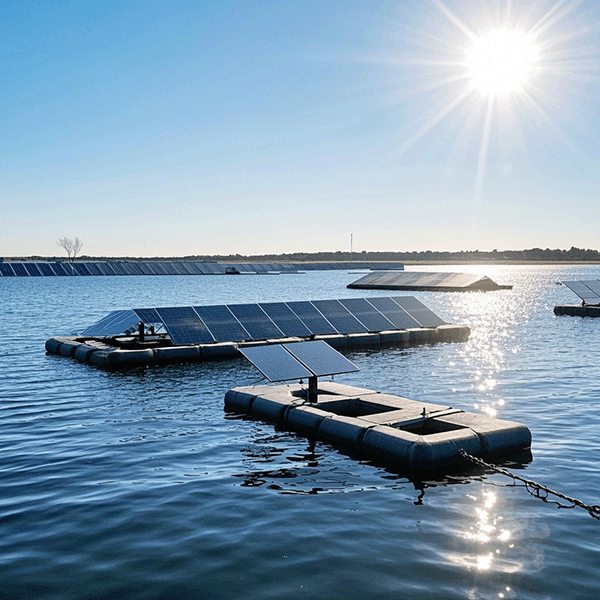
Floating solar power plants are emerging as a revolutionary solution in the renewable energy sector. As the world shifts toward sustainable energy sources, floating solar offers a unique way to harness solar energy without occupying valuable land. These systems are installed on large bodies of water, such as reservoirs, lakes, and man-made water bodies, making them an innovative alternative to traditional ground-mounted solar panels.
What Is Floating Solar and How Does It Work?
Floating solar, also known as floating photovoltaics (FPV), involves mounting solar panels on buoyant structures that float on water surfaces. These systems are designed to capture sunlight and convert it into electricity without the need for land. The panels are securely attached to floating platforms, ensuring they remain stable and efficient even in varying water conditions.
The electricity generated by the solar panels is transmitted to a central inverter through underwater cables. From there, the power is stepped down by a transformer and fed into the transmission system for distribution to end users. One of the standout benefits of floating solar is its ability to cool itself using the water beneath, which enhances the efficiency of the panels, especially in hot climates.
Components of a Floating Solar System
A floating solar system comprises several key components:
- PV Modules: The solar panels that capture and convert sunlight into electricity.
- Floaters: Interconnected plastic rafts that support the solar panels on the water surface.
- Mooring System (Anchors and Lines): Anchors secure the floating structure to the waterbed, while mooring lines connect the floaters to the anchors.
- Combine Box: Collects the output from all solar panels and channels it to the central inverter.
- Central Inverter: Converts the direct current (DC) generated by the panels into alternating current (AC) for use.
- Transformer: Steps down the voltage for efficient transmission.
- Cabling: Connects all components, ensuring seamless energy flow.
- Transmission System: Delivers the electricity to the grid or end users.
- Floating Walkways: Provide access for maintenance and inspection.
Features of Floating Solar
Leon Solar’s floating solar systems are designed with durability and efficiency in mind. The solar modules are highly resistant to humidity, dust, and water exposure. The buoyancy bodies are made from polyethylene, which can support up to 2.5 times their weight. Additionally, the floating structures are coated with a magnesium alloy to prevent corrosion, ensuring long-term performance.
Advantages and Disadvantages of Floating Solar
Преимущества:
- Land Conservation: Floating solar does not require valuable land, making it ideal for areas where land is scarce.
- Environmental Benefits: It reduces water evaporation and algae growth, while generating clean energy.
- Higher Efficiency: The cooling effect of water enhances the performance of solar panels, especially in warm climates.
Disadvantages:
- Higher Installation Costs: Floating solar systems require specialized equipment and expertise, making them more expensive to install than traditional systems.
- Limited Applicability: These systems are typically large-scale and may not be suitable for small-scale or residential use.
- Impact on Aquatic Life: The panels can block sunlight, potentially disrupting ecosystems in natural water bodies.
Maintenance of Floating Solar Panels
Floating solar panels require minimal maintenance due to the cooling effect of water. Rainfall often helps keep the panels clean. However, regular maintenance is still essential to ensure optimal performance. Methods include manual cleaning, using sprinklers, forced airflow, and robotic systems. While robotic cleaning systems have a higher upfront cost, they are efficient and reduce water waste.
Cost of Building a Floating Solar Power Plant
The cost of constructing a floating solar power plant varies based on factors such as size, location, and environmental conditions. Larger projects in sunny, calm areas are generally more cost-effective. While the initial investment is higher than traditional solar systems, the long-term benefits, such as reduced water evaporation and higher efficiency, make it a worthwhile investment.
Challenges of Floating Solar
Setting up a floating solar plant comes with unique challenges, including hydrodynamic loads, corrosion risks, and the need for specialized components like floats, anchors, and mooring lines. Site-specific design and assessment are crucial to mitigate these risks and ensure the project’s success.
Are Floating Solar Panels More Efficient?
Studies show that floating solar panels can be up to 10% more efficient than land-based systems due to the cooling effect of water. However, the primary advantage of floating solar lies in its ability to conserve land and reduce water evaporation, making it a valuable addition to the renewable energy landscape.
The Future of Floating Solar Farms
As renewable energy costs continue to decline, floating solar is becoming an increasingly viable option. While the initial installation costs are higher, the long-term benefits, such as improved efficiency and land conservation, make it a compelling choice. Leon Solar is at the forefront of this technology, offering innovative solutions that cater to diverse energy
